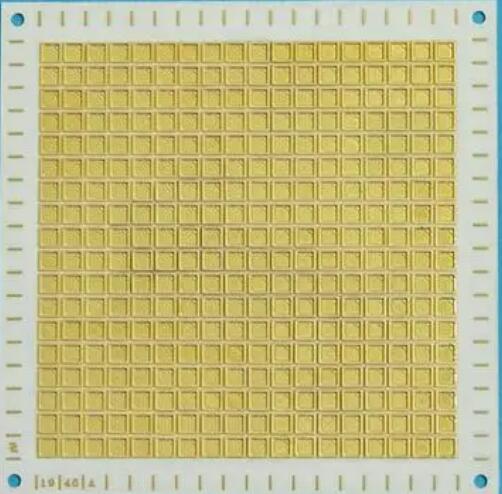Ceramic substrate refers to a special process plate where copper foil is directly bonded to the surface of alumina or aluminum nitride ceramic substrate at high temperatures. The ultra-thin composite substrate has excellent electrical insulation performance, high thermal conductivity, excellent soldering performance, and high adhesion strength. It can also etch various patterns like a PCB board and has a great current carrying capacity. Therefore, ceramic substrates have become the fundamental material for high-power power electronic circuit structure technology and interconnection technology.

Types of ceramic substrates
1 alumina ceramic substrate
Aluminum oxide ceramic substrate generally refers to a ceramic substrate material with aluminum oxide as the main raw material, mainly consisting of aluminum oxide crystal phase. The content of aluminum oxide accounts for over 75% of various types of ceramics. It has a rich source of raw materials, low cost, high mechanical strength and hardness, good insulation performance, and advantages such as good thermal shock performance, chemical corrosion resistance, high dimensional accuracy, and good adhesion to metal. It is a ceramic substrate material with good comprehensive performance. Aluminum oxide ceramic substrates are widely used in the electronic industry, accounting for 90% of the total ceramic substrate amount and have become an indispensable material in the electronic industry.
Aluminum oxide substrate is the most commonly used substrate material in the electronic industry, as it has high strength and chemical stability compared to most other oxide ceramics in terms of mechanical, thermal, and electrical properties, and has a rich source of raw materials. It is suitable for various technological manufacturing and different shapes.
2. Aluminum nitride ceramic substrate
Aluminum nitride ceramic substrate is a new type of substrate material. The lattice constants of aluminum nitride crystals are a=0.3110nm, c=0.4890nm, hexagonal crystal system, based on the tetrahedral structure unit of aluminum nitride, which is a covalent bonding compound of zinc ore. It has a series of excellent characteristics such as good thermal conductivity, reliable electrical insulation, low dielectric constant and loss, non-toxic, and matching with the thermal expansion coefficient of silicon, It is considered an ideal material for the new generation of high integration semiconductors substrates and electronic packaging.
3. Silicon nitride ceramic substrate
Silicon nitride has three crystal structures, of which the most common form is a hexagonal structure. Silicon nitride has many excellent properties such as high hardness, high strength, low thermal expansion coefficient, good oxidation resistance, good thermal corrosion performance, and low friction coefficient. The theoretical thermal conductivity of single-crystal silicon nitride is as high as 400W/(m.k), which has the potential to become a high thermal conductivity substrate. In addition, the thermal expansion coefficient of silicon nitride is about 3.0x10-6 ℃, which has good compatibility with materials such as Si, SiC, GaAs, etc., making silicon nitride ceramic substrate a very attractive high-strength and high thermal conductivity electronic device substrate material.
4. Silicon carbide ceramic substrate
Silicon carbide ceramic substrates have high thermal conductivity, ranging from 100W/(m ? k) to 400W/(m ? k) at high temperatures, which is 13 times higher than alumina. Good oxidation resistance, decomposition temperature above 2500 ℃, can still be used in an oxidation atmosphere of 1600 ℃ and has good electrical insulation. The thermal expansion coefficient is lower than that of alumina and aluminum nitride. Silicon carbide ceramic substrates have strong covalent bonding properties and are difficult to sinter. Usually, a small amount of boron or alumina is added as a sintering aid to increase density. Experiments have shown that beryllium, boron, aluminum, and their compounds are the most effective additives, which can increase the density of SiC ceramics to over 98%.
The main ceramic substrates are commonly used in electronic packaging. Compared to plastic and metal substrates, ceramic substrates have the following advantages:
1) Good insulation linearity and high reliability.
2) Low dielectric coefficient and good high-frequency performance.
3) Low thermal expansion coefficient and high thermal conductivity coefficient.
4) Good airtightness, stable chemical performance, and strong protective effect on electronic systems.
The ceramic substrate is suitable for packaging products with high reliability, high frequency, high-temperature resistance, and airtightness in aviation, aerospace, and military engineering. Subminiature SMD electronic components are widely used in fields such as mobile communication, computers, household appliances, and automotive electronics, and their carrier materials are often encapsulated on ceramic substrates.
The core advantage of ceramic substrates is strong mechanical stress and stable shape; High strength, high thermal conductivity, and high insulation; Strong adhesion and corrosion resistance; Has excellent thermal cycling performance; High reliability.